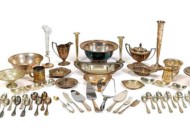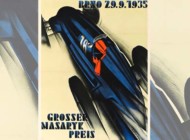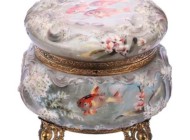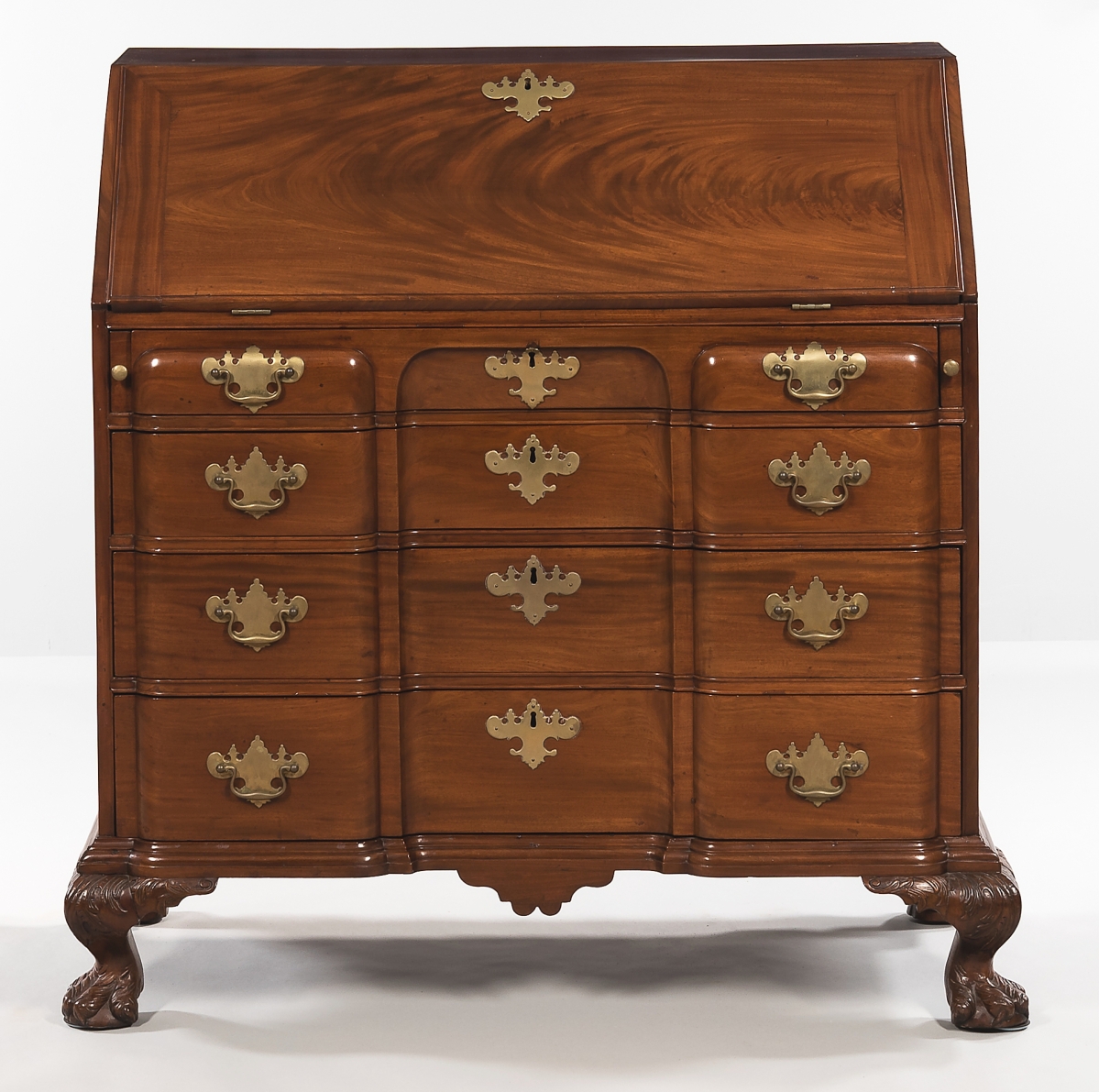
One of the two pieces of furniture that tied for first place in the sale was this circa 1760-80 refinished Boston blockfront desk, which had fan-carved serpentine interior drawers and hidden compartments. It finished at $25,000.
Review by Rick Russack, Additional Photos Courtesy Skinner Inc.
MARLBOROUGH, MASS. – Skinner combined two Connecticut collections, each built around objects with original surfaces, into a very successful sale. Those collections, belonging to Donald Reid of Glastonbury and Judi and Cy Stellmach of Stafford Springs, were supplemented by several lots from Historic Deerfield, as well as other collections.
Those visiting the Skinner gallery during the long preview would have immediately been aware of the commonality of the offerings. Add in folk art, mocha, fraktur and early lighting and the result was a coherent offering of fine Americana. It would have been difficult for a collector or someone furnishing a home to decide to limit their purchases to just a single item – it could have all gone together. It was a timed, online-only sale with by-appointment previews running over a 12-day period. In addition to the Internet bidding, phone lines were active and absentee bids were executed. A few days before the sale, Steve Fletcher and Chris Barber did a “live” video walk-through of the gallery, talking about objects and what they believed made the item of interest. The video of that walk-through was later available on YouTube. A total of 11 items brought five-figure prices, and the sale, which ended on April 12, grossed $1,109,200.
Cy and Judi Stellmach own Blue Dog Antiques in Stafford Springs and often exhibit at New England shows, as well as selling online. Their focus is on items with early painted surfaces along with mellow, aged original surfaces. Discussing the sale a few days later with Judi, she said that they were very pleased the results. “We’re moving to a different house, so we sold it all. We think Skinner did a good job. Steve Fletcher and Chris Fox came down to look at our stuff. We discussed the stories about where we had bought things and what we knew. They were both in close touch with us through the whole process. The stuff we sold was from our home – our personal collection. It had not been seen, as we never sold out of house.” The sale’s other major consignor, Don Reid, enjoyed collecting items made and/or used in Connecticut, including painted furniture, banister back chairs, early bottles, brass and lighting. Historic Deerfield occasionally deaccessions items, this time it was also objects with old paint and interesting smalls that may be duplicates of items in the museum’s collections, or items that no longer fit its collection, so everything looked good together.
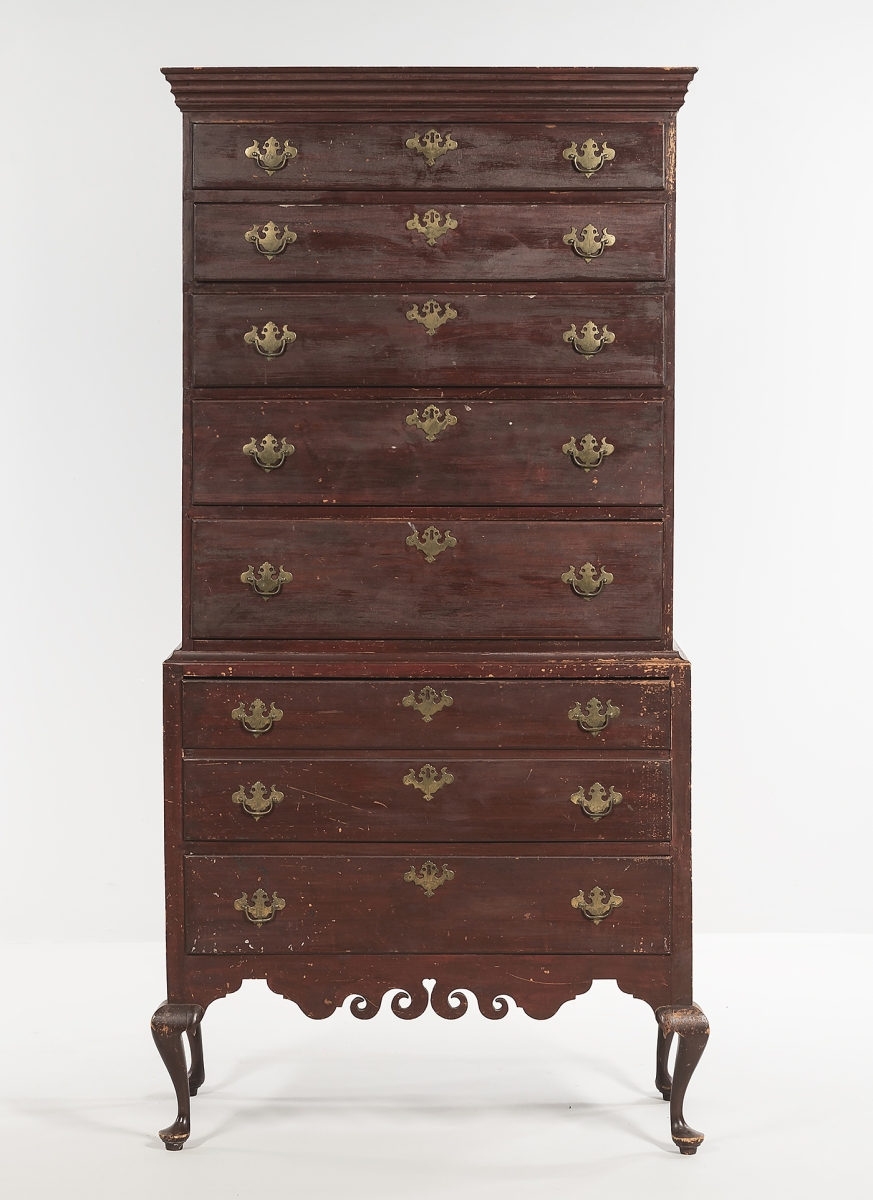
Bringing $25,000, this circa 1780-1800 Dunlap chest-on-chest had a flat molded cornice above five graduated drawers, and the lower section had two drawers. Attributed to Samuel Dunlap, the cabriole legs ended in pad feet and it had a heart scroll valance, typical of the Dunlap school. It was cataloged “with minor imperfections.”
Two early pieces of furniture tied for top spot in terms of highest price achieved. And they couldn’t be more different – one a formal Massachusetts Chippendale mahogany block front desk and the other a country red-painted chest-on-chest attributed to Samuel Dunlap of New Hampshire. Both pieces sold for $25,000. The circa 1760-80 refinished Boston blockfront desk had fan-carved serpentine interior drawers with hidden compartments, graduated drawers on a base with well carved hairy-paw feet and a center pendant. It had been sold by Skinner in 1990. The circa 1780-1800 Dunlap chest-on-chest had a flat molded cornice above five graduated drawers, and the lower section had two drawers. It had cabriole legs ending in pad feet with a heart scroll valance, typical of the Dunlap school. It was cataloged “with minor imperfections” and had been illustrated in The Dunlaps and Their Furniture by Charles Parsons. In keeping with today’s trend, an Eldred Wheeler tiger maple reproduction Dunlap school chest-on-chest sold for $7,500.
An unusual cherry and maple inlaid bowfront half sideboard, attributed to Rufus Norton, Windsor, Vt., circa 1810-15, rounded out the top three highest priced pieces of furniture. The form is unusual, and examples by Norton are few. His work is described in Rich and Tasty: Vermont Furniture to 1850 by Jean M. Burks and Philip Zea, published by the Shelburne Museum. The sideboard sold for more than twice the high estimate, finishing at $16,250. Pieces of furniture with old, dark, natural finishes were sought-after. An Eighteenth Century pine cupboard with deeply molded cornice over two paneled doors and hinges that were probably original sold for $11,875, nearly three times estimate. Pieces with old, red or blue finishes also did well. An Eighteenth Century 66-inch red painted settle showing natural signs of its age sold for $11,250 against a high estimate of $2,500. An Eighteenth Century maple and pine chair table, possibly from Cape Cod, finished at $6,875. Pieces in old blue were also offered. A robin’s-egg blue blanket chest from Historic Deerfield brought $5,313. The Eighteenth Century chest had three drawers and simple cut-out bracket feet. An early Nineteenth Century blue painted stepback cupboard with a recessed panel door over an earlier green paint reached $2,875.
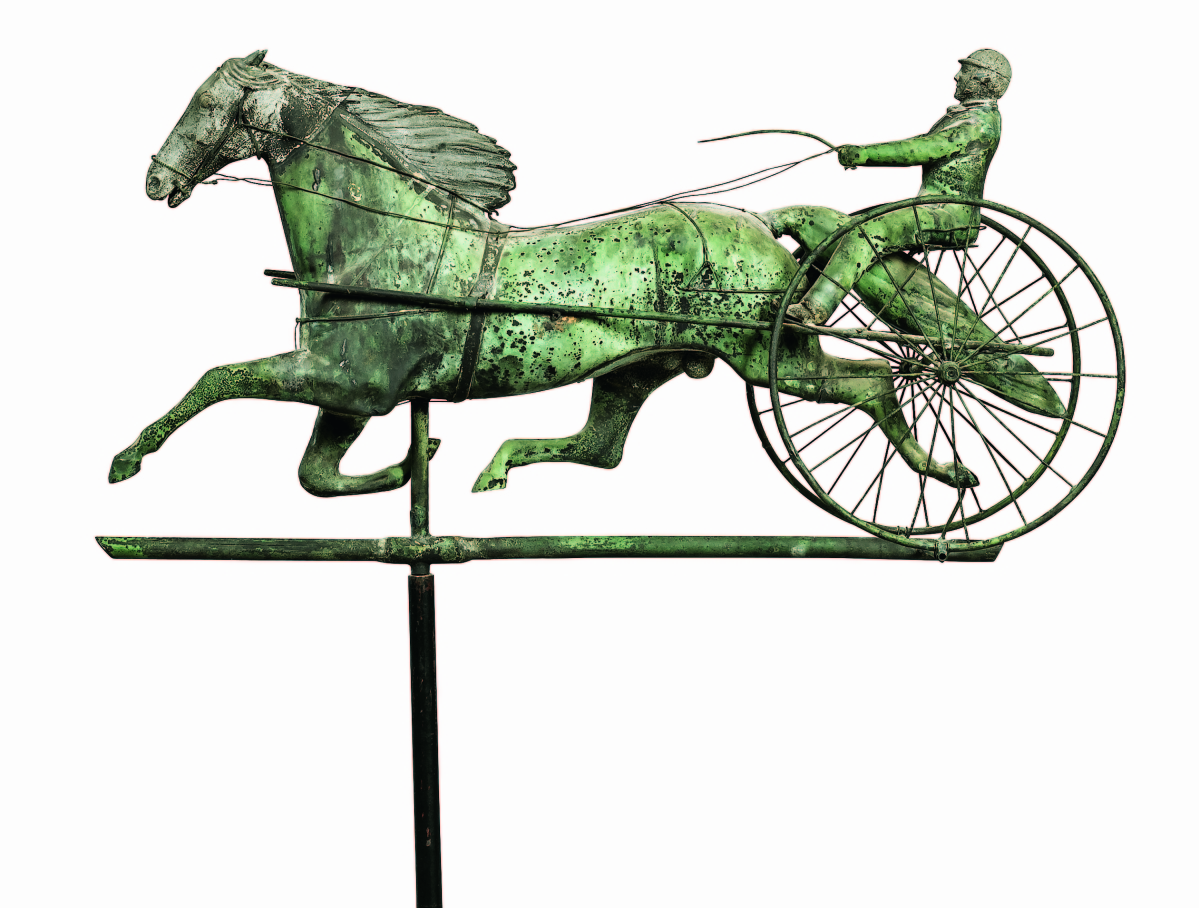
There were a number of good weathervanes in the sale. This unusually small horse with sulky and driver was only 29 inches long. The horse’s mane was cast zinc, as was the head, and it realized $23,750.
It wasn’t all furniture. An unusually small horse and sulky copper and zinc weathervane with a driver, consigned by Historic Deerfield, was one of the top three highest priced items in the sale, finishing at $23,750. It was only 29 inches long with an original, well-weathered surface. An unusual feature was the horse’s mane – it was molded zinc, while most are copper. A large, full-bodied 63-inch molded stag weathervane with antlers and a well-weathered surface reached $8,750. A 30-inch horse and rider weathervane with a flattened full-body horse also had an unusual feature. The rider had an applied, embossed strip on his jacket representing buttons. It went out at $10,000. Other horse weathervanes were offered.
Folk art included a group of miniature birds carved by Jess Blackstone, a New Hampshire woodcarver who died in 1988. He lived in Peterborough, N.H., and sold most of his work through the League of New Hampshire Craftsmen. A carved and painted humming bird perched on a branch, 8 inches tall, sold for $3,500 and a carved and painted towhee, less than 3 inches tall, sold for $1,625.
A collection of a few dozen pieces of mocha included some outstanding examples: large pitchers, a covered cider jug, coffee pots and a covered bowl. When previewing the collection, a standout piece was a large, barrel-form pitcher. It was 11 inches tall, decorated with grey and brown slip with alternating bands of rust and dark brown slip. It had condition issues and sold for $2,375. It was far from the highest priced piece in the collection. That distinction would go to a pint mug, just under 5 inches tall. It was decorated with three multicolor fans against a background of yellow slip and it earned $5,313. Also doing well was a 4-inch pepper pot decorated with three dipped fans on a rust background. Its pierced top was marbleized, and it finished at $3,250.
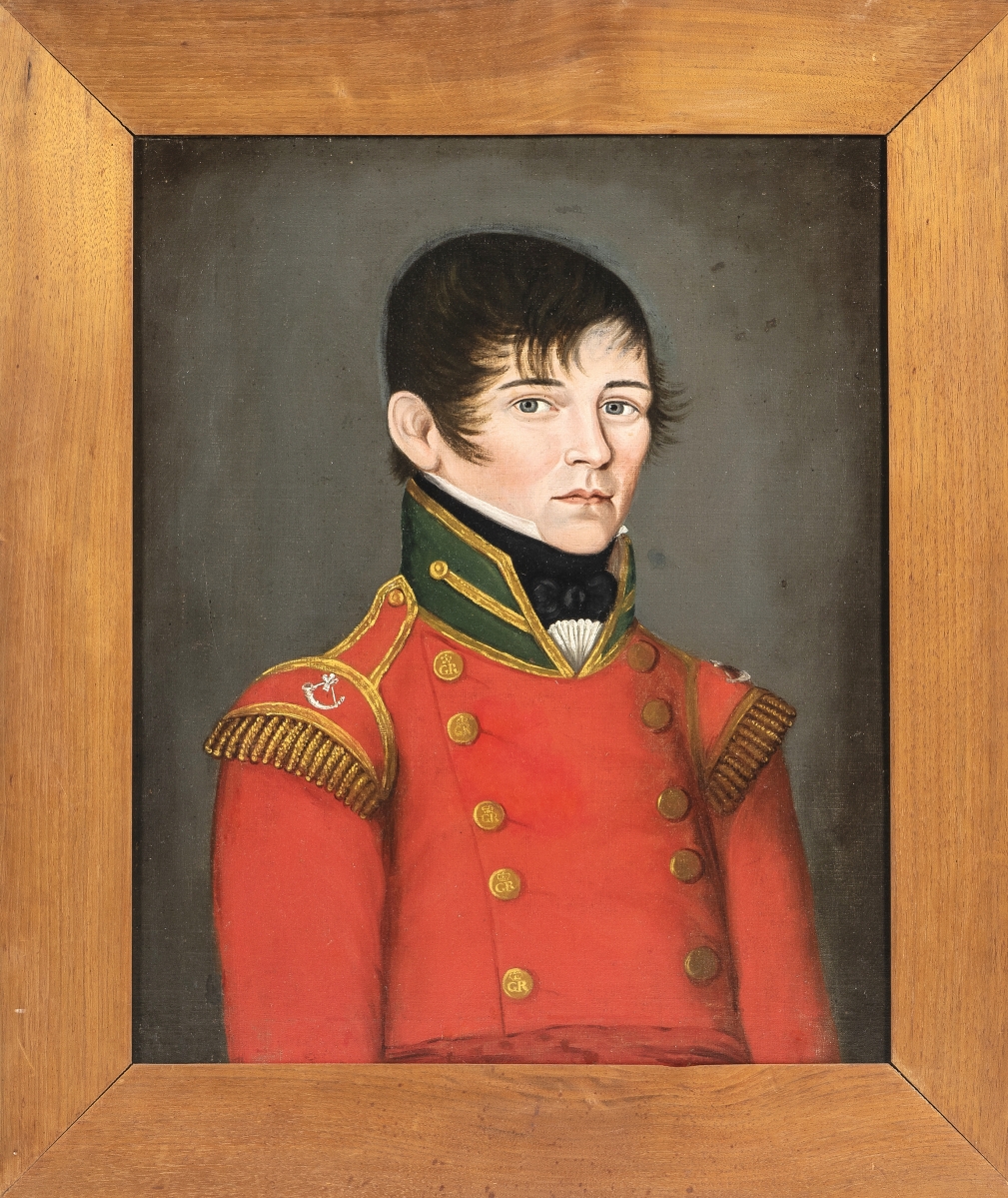
It would have looked good with the furniture in this sale and realized $22,500. This unsigned portrait of a Canadian military officer, Robert Richardson, was inscribed on the reverse “Robt. Richardson’s Portrait/taken the 21 day of May/Montreal in the year/1814.”
The sale featured many surprising smalls. One such surprise was a badly damaged and crudely repaired, small Eighteenth Century English slip decorated redware bowl that might more accurately be described as a fragment. The bowl is inscribed “Don’t Spill Your Milk,” but was dropped when the consignor was showing it to a friend and it broke into several pieces. What could be found was glued back together but good-sized pieces were missing. Regardless, it sold for $594. A well-marked silver tablespoon made by Paul Revere Jr was engraved with a boar’s head crest and wriggle-work along the handle. With good provenance, it sold for $16,250. One of the more unusual objects was a make-do bee-box. Bee-boxes may not be rare, but this one had been made from a pantry box. It had a glass top, a sliding door on the bottom and, most interestingly, a large piece of a beehive inside. The Stellmachs had bought it “years ago” from Peter Eaton and it sold for $625. A small George Washington Inaugural button, circa 1789, with a bold, spread-winged eagle and inscribed “March The Fourth 1789 Memorable Aera” fetched $5,938.
The sale included several paintings that would go well with the furnishings offered. An unsigned portrait of Canadian military officer Robert Richardson, inscribed on the reverse “Robt. Richardson’s Portrait/taken the 21 day of May/Montreal in the year/1814,” was also inscribed with the subject’s name in pen along a stretcher. It was in a period, canted frame and sold for $22,500. The catalog description included a detailed condition report, including the results of examination under black light. A realistic Nineteenth Century farm scene with a woman at a well, outbuildings, stacked firewood, a doghouse and more sold for $6,875. It was signed and dated “F. Collins 92.” A relaxing, panoramic landscape depicting the oxbow of the Connecticut River from Mount Holyoke brought $5,313. It was unsigned but attributed to Victor de Grailly (1804-1889).
We always talk about the highest priced items in a sale, but there were many items that sold for less than $500. An American signed still life of grapes sold for $200, an unsigned Nineteenth Century portrait of a gentleman brought $375, a grey-painted Nineteenth Century poplar side table sold for $250, two early Nineteenth Century English hog-scraper candlesticks sold for $313, a painted pine parcheesi board brought $188, and there were many such items. One need not spend thousands of dollars to get “the look.”
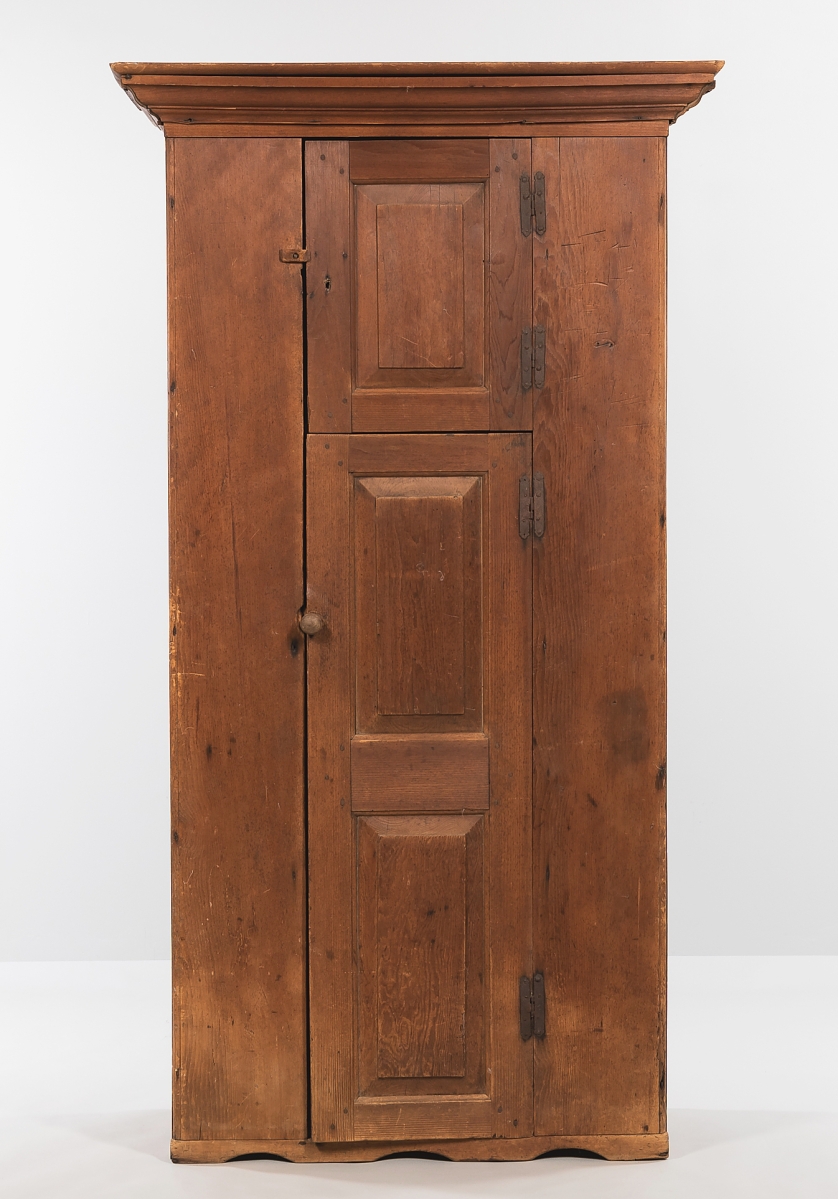
At $11,875, nearly three times the estimate, an Eighteenth Century pine cupboard with two paneled doors and hinges that were probably original, was one of the pieces with a mellow, original, weathered patina. Just over 6½ feet tall, it probably originated in New Hampshire.
A few days after the sale, Steve Fletcher commented, “We were quite pleased with the way it all worked out. Again, we talked to a lot of new bidders for whom this was a first experience, and we’re happy to take the time to get those folks comfortable with the process. The video walk-through worked well, and we had a lot of questions afterwards from people who had watched. There was a lot of quirky stuff and it all got noticed, and the prices reflected that. I’ve spoken to our consignors and they’re happy. Some of the things were exceptional, like the Paul Revere spoon and the red-painted knife box with the heart cutout that brought a whole lot more than we thought it would. It was a great example and people knew it. We did about $1.1 million so that’s encouraging, and we’re getting ready for the next one, which will be in August. We have some good stuff for that one.”
Prices given include the buyers’ premium as stated by the auction house. For information, 508-970-7311 or www.skinnerinc.com.





























